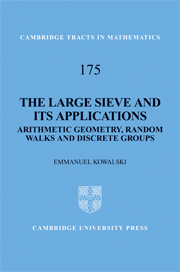Book contents
- Frontmatter
- Contents
- Preface
- Acknowledgments
- Prerequisites and notation
- 1 Introduction
- 2 The principle of the large sieve
- 3 Group and conjugacy sieves
- 4 Elementary and classical examples
- 5 Degrees of representations of finite groups
- 6 Probabilistic sieves
- 7 Sieving in discrete groups
- 8 Sieving for Frobenius over finite fields
- Appendix A Small sieves
- Appendix B Local density computations over finite fields
- Appendix C Representation theory
- Appendix D Property (T) and Property (τ)
- Appendix E Linear algebraic groups
- Appendix F Probability theory and random walks
- Appendix G Sums of multiplicative functions
- Appendix H Topology
- References
- Index
8 - Sieving for Frobenius over finite fields
Published online by Cambridge University Press: 05 October 2009
- Frontmatter
- Contents
- Preface
- Acknowledgments
- Prerequisites and notation
- 1 Introduction
- 2 The principle of the large sieve
- 3 Group and conjugacy sieves
- 4 Elementary and classical examples
- 5 Degrees of representations of finite groups
- 6 Probabilistic sieves
- 7 Sieving in discrete groups
- 8 Sieving for Frobenius over finite fields
- Appendix A Small sieves
- Appendix B Local density computations over finite fields
- Appendix C Representation theory
- Appendix D Property (T) and Property (τ)
- Appendix E Linear algebraic groups
- Appendix F Probability theory and random walks
- Appendix G Sums of multiplicative functions
- Appendix H Topology
- References
- Index
Summary
In this final chapter, we will describe the use of the large sieve to study the average distribution of (geometric) Frobenius conjugacy classes in Galois groups of coverings of algebraic varieties over finite fields, or equivalently in a more geometric language that we will use instead, in finite monodromy groups of sheaves obtained by reduction of integral ℓ-adic sheaves. This sieve is a good example (in fact, the most interesting at the moment) of a coset (conjugacy) sieve, as defined in Section 3.3.
This type of sieve was introduced in [80], and its strengthening was the motivation for the paper from which this book evolved. We will recall enough of the previous work to make the argument independent of results in [80].
As explained in Example 4.10, there is nothing to prevent adapting the ideas to sieve for Frobenius conjugacy classes over number fields, except that really good results depend at present on assuming some form of the Generalized Riemann Hypothesis (though weaker unconditional bounds are possible, see D. Zywina's preprint ‘The large sieve and Galois representations’, 2007).
Contrary to what we have done in all previous applications of the sieve, we have not attempted to give entirely self-contained definitions; here, we need to introduce some ‘black boxes’. Hopefully, the examples of applications (which we can, and do, describe from scratch) will be sufficiently interesting to encourage interested readers to get better acquainted with the foundations and in particular with Deligne's work on the Riemann Hypothesis over finite fields.
- Type
- Chapter
- Information
- The Large Sieve and its ApplicationsArithmetic Geometry, Random Walks and Discrete Groups, pp. 154 - 196Publisher: Cambridge University PressPrint publication year: 2008



